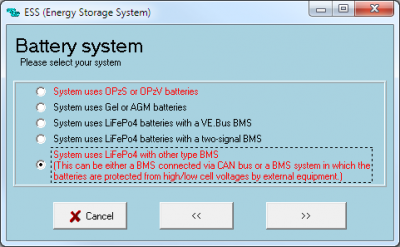This is an old revision of the document!
Table of Contents
Victron Energy and BlueNova Energy LiFePo4 Batteries
The BlueNova Energy (www.bluenova.co.za) range of Lithium Iron Phosphate batteries is compatible with Victron products in various systems.
1.1 Product and System Compatibility
Victron + BlueNova can be used for the following systems
1.Off Grid 2.Backup 3.Energy Storage
1.2 Colour Control GX or VenusGX is required
When used with BlueNova Batteries the minimum firmware version for the Colour Control / Venus G X is v2.02. It is recommended to always use the latest Firmware version for the Colour Control/Venus GX.
1.3 All 48V Multi’s, MultiPlus, MultiPlus II, Multigrids and Quattros are compatible
When the BlueNova battery is installed in a Victron ESS installation, which is the best solution for Energy Storage Systems, there is no need for additional control wiring. For other systems, such as off- grid systems and backup systems, the internal BMS controls will control deep discharge and overcharge conditions. Please contact BlueNova for more information. For more Victron-related settings see the VEConfigure section below
2.BlueNova Energy product range
The BlueNova range is supplied with a BMS as standard on all current models of batteries . See the BlueNova product page for more details on the various options.
3. Wiring of Can.Bus cable between BlueNova and CCGX.
No RJ45 cable is supplied for this connection .
Plug the CCGX/VenusGX side of the cable into one of the VE.Can sockets on the back of the CCGX/VenusGX. Plug the other end into the battery at one of the RJ45 CANbus ports. A VE.Can terminator is not nescessary for the other VE.Can socket on the CCGX/VenusGX. Without properly connecting this cable, the battery will stop charging/discharging after several minutes. Also, the battery will not show up on the display of the CCGX/VenusGX.
4. VEConfigure settings
4.1 Charge parameters
4.2 ESS Assistant
5. Color Control GX Configuration
Select the VE.Can & CAN-bus BMS (250 kbaud) CAN-profile in the CCGX. Menu path: Settings → Services → CAN-profile. Note that this changes the function of a VE.Can port: it is not possible to connect both VE.Can products and a Bluenova battery together.
After properly wiring and setting up, the BlueNova will be visible as a battery in the device list:
If you have multiple batteries, a single entry will show up, which represents all batteries. The parameters option within the battery page shows the actual battery charge and discharge limits.
==== 6. BlueNova Energy battery setup with DVCC enabled (DVCC - Distributed Voltage and Current Control) ====
Introduction and features
Enabling DVCC in a setup containing a BlueNova Energy battery, changes the GX device from a passive monitor into an active controller.
The GX device receives the Charge Voltage Limit (CVL), Charge Current Limit (CCL), Discharge Current Limit (DCL) as well as the Battery Low Voltage from the battery and relays that to the connected inverter/chargers and solar chargers. These then disable their internal charge algorithms and simply do what they're told by the battery. There is no need to set-up charge voltages or choose the charge algorithm type.
Shared Voltage Sense (SVS) Works with VE.Bus devices and VE.Direct Solar Chargers.
The system automatically selects the best available voltage measurement. It will use the voltage from the BlueNova Energy battery BMS or a BMV battery monitor, if possible, otherwise it will use the battery voltage reported by the VE.Bus system. The voltage displayed on the GUI reflects the same voltage measurement.
Shared Voltage Sense (SVS) is by default enabled when DVCC is enabled. It can be disabled with a switch in the Settings → System Setup menu.
Limit charge current - This is a user-configurable maximum charge current setting and can, in majority of cases, be disabled for BlueNova Energy batteries. It works across the whole system. MPPT Solar Chargers are automatically prioritized over the mains/generator.
To enable or disable DVCC, see Settings → System Setup in the menus.
DVCC Requirements :
Battery compatilibity -
DVCC has extensively been tested on BlueNova Energy batteries and is therefore fully supported .
Firmware versions :
Do not use DVCC in cases where these requirements(Victron) are not met. In all cases we recommend to install the latest available firmware during commissioning. Once running well, there is no need to pro- actively update firmware without reason. In case of difficulty, the first action is to update firmware.
Required minimum firmware versions:
BlueNova Energy 123SmartBMS : v5.12
BlueNova Energy BMMC : V3.5
Multi/Quattro: 422
MultiGrid: 424
CCGX / Venus GX: v2.12 VE.Direct MPPTs: v1.29
VE.Can MPPT Solar Chargers cannot be used: they do not yet support the new control mechanisms. Lynx Ion + Shunt: v2.04 Lynx BMS: v1.09
In case of an ESS System, the ESS Assistant needs to be version 164 or later (Released in November 2017).
7. Configure MPPT
- Disable Autodetect voltage
- Set Battery voltage to 48V.
It is recommended to make these settings using the VictronConnect App and Bluetooth.
** - All latest GX devices applicable.
DISQUS
~~DISQUS~~
 Add this page to your book
Add this page to your book  Remove this page from your book
Remove this page from your book  Manage book (
Manage book ( Help
Help 






